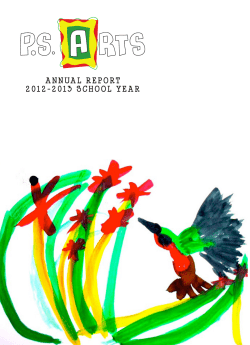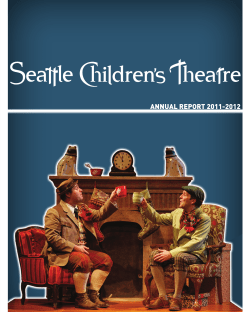
What is … a topos? Z.L. Low 17 January 2013
What is … a topos?
Z.L. Low
17 January 2013
Abstract
The words ‘topos theory’ seem to strike unnecessary fear in the hearts
of mathematicians. I shall try to defuse some of this apprehension by explaining what a topos is in simple terms and why they are interesting. We
will see three aspects of the elephant in this talk: toposes as mathematical
universes, toposes as generalised spaces, and toposes as theories.
0
Historical overview
The notion of topos was originally conceived by Grothendieck as part of his
programme to attack the Weil conjectures via the construction of a so-called
‘Weil cohomology theory’. The results of this research was eventually collected
in [SGA 4], but can be traced back as early as [G–S, July 18, 1959]; the idea
behind étale topology goes back even further and is mentioned in Grothendieck’s
address at the International Congress of Mathematicians in 1958.[1] Roughly
speaking, a topos in the sense of Grothendieck is the category of sheaves on a
kind of generalised space whose “points” may have non-trivial automorphisms.
In fact, topos cohomology is almost literally a fusion of Galois cohomology and
classical sheaf cohomology.[2] Moreover, just knowing the topos of sheaves on a
sufficiently nice (e.g. Hausdorff) space is enough to recover that space; and for
locally contractible spaces, invariants such as homotopy groups can be computed
[1]
See [Grothendieck, 1960].
More precisely, every Grothendieck topos is equivalent to the topos of equivariant sheaves
on a localic groupoid; see [Joyal and Tierney, 1984].
[2]
1
What is … a topos?
directly from the topos—in principle even without knowing what the unit interval
is! Consequently Grothendieck and his followers advocated the view that a topos
is a space, albeit one that could be very strange.
However that is at best only one-half of the story. Around the same time,
Lawvere was looking for an elementary axiomatisation of the category of sets—
and in particular, set theory without a global membership relation. It is worth
remarking that even Mac Lane was sceptical about this endeavour; he said, “Bill,
you can’t do that. Elements are absolutely essential to set theory.”[3] Lawvere’s
formulation of the ‘elementary theory of the category of sets’ (ETCS) was published in [1964],[4] the very same year that the theorem of Giraud [1964] characterising Grothendieck toposes was published. This set the stage for Lawvere and
Tierney’s research on ‘axiomatic sheaf theory’, which produced elementary axioms for a class of categories including Grothendieck toposes. Lawvere [1971]
announced these axioms for what we know today as ‘elementary toposes’ and
‘local operators’ at the International Congress of Mathematicians in 1970, and
the rest is, as they say, history.
Almost. I promised to also say something about ‘toposes as theories’, and
the origins of this idea seems somewhat more obscure than the others. The first
concrete example of a classifying topos for a non-trivial logical theory was perhaps the Zariski topos; its universal property, and an analogous one for the étale
topos, appeared in the thesis of Hakim [1972]—but the phrase ‘topos classifiant’
does not! Rather, that was probably due to Giraud [1971, Ch. VIII], who showed
that (for example) the category of objects equipped with the action of an internal
group 𝐺 classifies 𝐺-torsors. The English phrase ‘classifying topos’ was also
the title of a [1972] paper of his.
Another example of a relative classifying topos appeared in the lectures of
Wraith [1975, § 9], namely the relative object classifier. The key theorem for this
work was due to Diaconescu [1973, 1975]. In the same book, Johnstone [1975]
gave a construction for relative classifying toposes for finitely-presented finitary algebraic theories; then finally, Bénabou [1975], Tierney [1976], and others
showed that relative classifying toposes exist for all geometric theories, a fragment of infinitary first-order logic due to Joyal [unpublished], Makkai [1976],
and Reyes [1974]. In this light Diaconescu’s theorem is seen as a converse:
every bounded topos classifies models for some geometric theory.
[3]
[4]
See [Mac Lane, 1988, § 15].
— and later republished in [2005].
2
What is … a topos?
1
A mathematical universe
Definition 1.1. A category 𭒮 is a model of the elementary theory of the category of sets (ETCS) if it satisfies the following axioms:
1. 𭒮 has all finite limits and colimits; more precisely, 𭒮 is required to have
an initial object 0, a terminal object 1, binary coproducts, pullbacks, and
coequalisers.
2. 𭒮 is cartesian closed, i.e. for each object 𝑌 in 𭒮 the endofunctor on 𭒮
defined by 𝑋 ↦ 𝑋 × 𝑌 has a right adjoint, denoted by 𝑍 ↦ 𝑍 𝑌 .
3. 𭒮 has a natural numbers object, i.e. an object 𝑁 in 𭒮 equipped with a pair
morphisms, 𝑧 ∶ 1 → 𝑁 and 𝑠 ∶ 𝑁 → 𝑁, such that for any morphisms
𝑧𝑋 ∶ 1 → 𝑋 and 𝑠𝑋 ∶ 𝑋 → 𝑋, there is a unique morphism 𝑓 ∶ 𝑁 → 𝑋
such that 𝑓 ∘ 𝑧 = 𝑧𝑋 and 𝑓 ∘ 𝑠 = 𝑠𝑋 ∘ 𝑓 .
4. 𭒮 is well-pointed, i.e. for any pair of morphisms 𝑓 , 𝑔 ∶ 𝑋 → 𝑌 in 𭒮, if
𝑓 ∘ 𝑥 = 𝑔 ∘ 𝑥 for all morphisms 𝑥 ∶ 1 → 𝑋, then 𝑓 = 𝑔.
5. 𭒮 satisfies the axiom of choice, in the sense that all epimorphisms in 𭒮
split.
6. 𭒮 is non-degenerate, i.e. the canonical morphism 0 → 1 is not an isomorphism.
7. 𭒮 has a subobject classifier, i.e. a monomorphism ⊤ ∶ 1 ↣ Ω such
that, for every monomorphism 𝑚 ∶ 𝑋 ↣ 𝑌 in 𭒮, there exists a unique
morphism 𝜒𝑚 ∶ 𝑌 → Ω fitting into a pullback square of the form below:
𝑋
1
𝑚
⊤
𝑌
𝜒𝑚
Ω
Axioms 1–5 above are exactly the same axioms that Lawvere gave in [1964],
and the axioms regarding non-degeneracy and the existence of a subobject classifier replace the original axioms 6–8. It is now known that ETCS is essentially
the same as RZC (or ZBQC in the notation of Mathias [2001]), a weak form
of Zermelo set theory that only has Δ0 -separation; accordingly there are many
models of ETCS.
3
What is … a topos?
Example 1.2. Let 𝑉 be a model of Zermelo–Fraenkel set theory with choice
(ZFC). Then the category of sets and functions in 𝑉 is a model of ETCS. Moreover, inside 𝑉 , the category of sets and functions in 𝑉𝜔+𝜔 is also a model of
ETCS.
Now, what does ETCS have to do with toposes?
Definition 1.3. An elementary topos is a category that satisfies axioms 1, 2,
and 7 of ETCS.
This was precisely the definition that Lawvere and Tierney settled on in 1970.
Thus we may think of an elementary topos as being a category of generalised
sets; conversely, an elementary topos with some additional properties will look
a lot like the category of sets as we normally understand it. The following reformulation may be more convincing than mere talk:
Theorem 1.4. A category ℰ is an elementary topos if and only if it satisfies these
conditions:
• ℰ has finite limits.
• ℰ has power objects, i.e. for every object 𝑋 in ℰ there exist an object 𝑃 𝑋
and a monomorphism [∈]𝑋 ↣ 𝑋 × 𝑃 𝑋 such that for each monomophism
𝑅 ↣ 𝑋×𝑌 there is a unique morphism 𝑟 ∶ 𝑌 → 𝑃 𝑋 fitting into a pullback
diagram of the form below:
𝑅
𝑋×𝑌
[∈]𝑋
id𝑋 ×𝑟
𝑋 × 𝑃𝑋
Proof. See Corollaries A2.2.9 and A2.3.4 in [Johnstone, 2002], or Theorem 1 in
[ML–M, Ch. IV, § 2] plus Corollary 4 in [ML–M, Ch. IV, § 5].
□
Example 1.5. Let 𝑉 be a model of Zermelo–Fraenkel set theory (ZF), possibly
without choice. Then the category of sets and functions in 𝑉 is a non-degenerate
well-pointed elementary topos with a natural numbers object, and the full subcategory of finite sets is a well-pointed elementary topos with choice.
4
What is … a topos?
Lawvere often emphasises that a topos is a category of “variable sets”, so we
should see at least one an example of this before moving on.
Example 1.6. Let 𝐺 be any discrete group and let 𝔹𝐺 be 𝐺 considered as a
one-object category. If ℰ is any elementary topos, then [𝔹𝐺, ℰ], the category of
𝐺-objects in ℰ and 𝐺-equivariant morphisms, is also an elementary topos (with
limits, colimits, exponentials, and subobject classifier all as in ℰ).
So far this is still fairly tame. Here is a glimpse of something more general:
Definition 1.7. Let ℂ be a small category. A presheaf on ℂ is a functor of the
form ℂop → Set, and a morphism of presheaves is a natural transformation of
functors.
Proposition 1.8. For any small category ℂ, the presheaf category [ℂop , Set] is a
locally small elementary topos with coproducts for all small families of objects.
□
Proof. See [ML–M, Ch. I, §§ 4–6].
If we think of Ω as being the object of truth values, then this already implies
that the internal logic of an elementary topos can be very far from boolean! In
general, Ω will only be a Heyting algebra—reflecting the fact that the internal
logic of an elementary topos is intuitionistic. This can be regarded as a higherorder generalisation of Kripke’s frame semantics for intuitionistic logic.
2
A generalised space
Definition 2.1. Let 𝑋 be a space.[1] By presheaf on 𝑋 we mean a presheaf
on Ouv(𝑋), where Ouv(𝑋) is the category of open subspaces of 𝑋. We write
Psh(𝑋) for the category of presheaves on 𝑋.
If 𝐹 is a presheaf on 𝑋 and 𝑠 ∈ 𝐹 (𝑈 ), then for each open subspace 𝑈 ′ ⊆ 𝑈
we write 𝑠|𝑈 ′ for the image of 𝑠 under the map 𝐹 (𝑈 ) → 𝐹 (𝑈 ′ ) induced by the
inclusion. A sheaf on 𝑋 is a presheaf 𝐹 with the following property:
• Given an open cover 𝔘 of an open subspace 𝑉 ⊆ 𝑋 and any family of
elements (𝑠𝑈 | 𝑈 ∈ 𝔘) such that 𝑠𝑈 ∈ 𝐹 (𝑈 ) for all 𝑈 in 𝔘 and 𝑠𝑈 |𝑈 ∩𝑈 ′ =
𝑠𝑈 ′ |𝑈 ∩𝑈 ′ for all pairs (𝑈 , 𝑈 ′ ), there exists a unique element 𝑠 in 𝐹 (𝑉 ) such
that 𝑠|𝑈 = 𝑠𝑈 .
[1]
Throughout this section, ‘space’ can mean either topological space or locale.
5
What is … a topos?
The category of sheaves on 𝑋 is the full subcategory Sh(𝑋) of Psh(𝑋) spanned
by the sheaves on 𝑋.
Example 2.2. Let 𝑝 ∶ 𝐸 → 𝑋 be a continuous map. The sheaf of sections of
𝑝 defined to be 𝑈 ↦ {𝑠 ∶ 𝑈 → 𝐸 | 𝑝 ∘ 𝑠 = 𝑖𝑈 }, where 𝑈 varies over the open
subspaces of 𝑋 and 𝑖𝑈 ∶ 𝑈 ↪ 𝑋 is the inclusion. It can be shown using the
espace étalé construction that every sheaf on 𝑋 is isomorphic to the sheaf of
sections of some local homeomorphism.
Theorem 2.3. For any space 𝑋:
(i) Sh(𝑋) is a topos.
(ii) The inclusion Sh(𝑋) ↪ Psh(𝑋) has a left adjoint that preserves finite
limits.
(iii) The category of subobjects of 1 in Sh(𝑋) is equivalent to Ouv(𝑋).
In particular, if 𝑋 is either a locale or a sober topological space, then 𝑋 is
determined up to isomorphism by Sh(𝑋).
Proof. See [ML–M, Ch. II, §§ 5 and 8].
□
Rather than give the original, delicate definition of Grothendieck topos now,
let me instead give a concise one motivated by the above observation.
Definition 2.4. A Grothendieck topos is a category ℰ for which there exists a
small category ℂ and a fully faithful functor 𝑗∗ ∶ ℰ → [ℂop , Set], such that 𝑗∗
has a left adjoint 𝑗 ∗ that preserves finite limits. Such a choice of ℂ and 𝑗∗ is
called a site of definition for ℰ.
Example 2.5. Obviously, [ℂop , Set] is itself a Grothendieck topos, and the earlier
theorem says that Sh(𝑋) is a Grothendieck topos.
However, unlike Sh(𝑋), Grothendieck toposes in general do not have a canonical site of definition. This is an essential feature of topos theory and underlies the “bridges” technique of Caramello [2010].
There is an elephant in the room that we should address as soon as possible:
are these two notions of topos compatible?
Proposition 2.6. Every Grothendieck topos is an elementary topos.
6
What is … a topos?
Proof. See [ML–M, Ch. IV, §§ 6 and 7].
□
Now, recall the dictum of category theory that says that morphisms are just as
important as objects. If toposes are to truly generalise (nice) spaces, then there
should be some kind of full embedding of the category of (nice) spaces in the
2-category of toposes. But what is a morphism of toposes?
Definition 2.7. Let ℰ and ℱ be elementary toposes. A geometric morphism
𝑓 ∶ ℰ → ℱ is an adjunction 𝑓 ∗ ⊣ 𝑓∗ ∶ ℰ → ℱ such that 𝑓 ∗ ∶ ℱ → ℰ that
preserves finite limits. We call 𝑓 ∗ the inverse image functor and 𝑓∗ the direct
image functor. A transformation of geometric morphisms 𝑓 ⇒ 𝑔 is a natural
transformation of the inverse image functors 𝑓 ∗ ⇒ 𝑔 ∗ .
Of course, the above definition is not completely arbitrary and is motivated
by various considerations.
Example 2.8. If ℂ and 𝑗∗ ∶ ℰ → [ℂop , Set] constitute a site of definition for ℰ,
then 𝑗∗ together with 𝑗 ∗ determine a geometric morphism 𝑗 ∶ ℰ → [ℂop , Set].[2]
Theorem 2.9. Let 𝑋 and 𝑌 be spaces.
(i) For each continuous map 𝑓 ∶ 𝑋 → 𝑌 , there is a geometric morphism
𝑓 ∶ Sh(𝑋) → Sh(𝑌 ) such that
𝑓∗ 𝐹 (𝑉 ) = 𝐹 (𝑓 −1 𝑉 )
for all 𝐹 in Sh(𝑋) and all open subspaces 𝑉 ⊆ 𝑌 .
(ii) The passage from continuous maps to geometric morphisms is pseudofunctorial.
(iii) If 𝑋 and 𝑌 are locales, then each geometric morphism Sh(𝑋) → Sh(𝑌 )
is isomorphic to one induced by a unique continuous map 𝑋 → 𝑌 .
In particular, if 𝑋 and 𝑌 are sober topological spaces, then this construction
gives a bijection between continuous maps 𝑋 → 𝑌 and isomorphism classes of
geometric morphisms Sh(𝑋) → Sh(𝑌 ).
Proof. See [ML–M, Ch. II, § 9] and [Johnstone, 2002, § C1.4].
[2]
□
This is vacuous with our definition of Grothendieck topos, but requires hard work if one
instead uses any of the more standard definitions!
7
What is … a topos?
3
A geometric theory
The notion of classifying topos bears a strong resemblance to the notion of classifying space in homotopy theory. In order to define this notion, we need to know
what a ‘theory’ is, and for our purposes the following will suffice:
Definition 3.1. Let BTop be the 2-category of Grothendieck toposes, geometric
morphisms, and their transformations, and let Cat be the 2-category of locally
small categories, functors, and natural transformations. A theory is a pseudofunctor 𝕋 ∶ BTopop → Cat. A classifying topos for a theory 𝕋 is a Grothendieck topos Set[𝕋 ] equipped with equivalences 𝕋 (ℰ) ≃ Geom(ℰ, Set[𝕋 ]) that
are pseudonatural in ℰ.
The idea is that, whatever a theory 𝕋 really is, it should be something that
has a category of models 𝕋 (ℰ) in any Grothendieck topos ℰ, and we restrict our
attention to the theories 𝕋 such that models of 𝕋 can be pulled back along geometric morphisms. The functor 𝕋 (𝑓 ) is usually induced by the inverse image
functor 𝑓 ∗ , so one often writes 𝑓 ∗ instead of 𝕋 (𝑓 ).
Proposition 3.2. Let 𝕋 be a theory with a classifying topos Set[𝕋 ]. Then there
exists an object 𝐺 in 𝕋 (Set[𝕋 ]) with the following universal property:
• For each Grothendieck topos ℰ, the functor Geom(ℰ, Set[𝕋 ]) → 𝕋 (𝐸)
defined by 𝑓 ↦ 𝑓 ∗ (𝐺) is fully faithful and essentially surjective on objects.
In particular, for each object 𝐴 in 𝕋 (ℰ), there exists a geometric morphism 𝜒𝐴 ∶
ℰ → Set[𝕋 ] such that 𝐴 ≅ 𝜒𝐴∗ (𝐺), and 𝜒𝐴 is unique up to (not necessarily
unique) isomorphism. Such an object 𝐺 is said to be a universal model of the
theory 𝕋 .
Proof. Use the 2-dimensional Yoneda lemma.
■
It is not at all clear whether even the theory of objects (as embodied by the
forgetful 2-functor BTopop → Cat) has a classifying topos. To that end we require a theorem.
Theorem 3.3 (Diaconescu). Let ℰ be a Grothendieck topos. If ℂ is a small
category with finite limits and 𝒽• ∶ ℂ → [ℂop , Set] is the Yoneda embedding, then the functor 𝑓 ↦ 𝑓 ∗ 𝒽• is fully faithful and essentially surjective from
Geom(ℰ, [ℂop , Set]) onto the category of functors ℂ → ℰ that preserve finite
limits.
8
What is … a topos?
Proof. This is, strictly speaking, a special case of what Diaconescu proved. See
[ML–M, Ch. VII, §§ 6–9], or [Johnstone, 2002, § B3.2].
□
Corollary 3.4. Let FinSet be the category of (hereditarily) finite sets. The topos
[FinSet, Set] is a classifying topos for the theory of objects. We say it is the
object classifier.
Proof. Any functor 𝐴 ∶ FinSetop → ℰ that preserves finite limits is determined
up to unique isomorphism by 𝐴(1).
■
More generally:
Proposition 3.5. Let 𝕋 be a finitary algebraic theory, i.e. a first-order logical
theory over a finitary signature containing no relation symbols and axiomatised
by a set of equations. Let 𭒜 be (a small skeleton of) the category of all finitelypresentable models of 𝕋 . Then [𭒜, Set] is a classifying topos for 𝕋 .
Proof. See Theorem B3.1.1 in [Johnstone, 2002].
□
What about more general theories? It is a fact that that every theory in a certain fragment of infinitary first-order logic, called geometric logic, has a classifying topos. Essentially, given a geometric theory 𝕋 , one constructs a small
category ℂ based on the syntactic properties of 𝕋 ; the axioms of 𝕋 are then
translated into a “forcing topology” defining a subtopos of [ℂop , Set]. Geometric logic is also just expressive enough to be able to axiomatise the theory of
geometric morphisms into any fixed Grothendieck topos 𭒢: given a site of definition (ℂ, 𝑗∗ ), the “topology” on ℂ induced by 𝑗∗ may be regarded as an extension
of the theory of finite-limit-preserving functors with domain ℂ.
Thus, every Grothendieck topos can be considered as a geometric theory
modulo pseudonatural equivalence of the categories of models. In particular,
one might ask what the Zariski topos of an affine scheme Spec(𝐴) classifies.
Theorem 3.6 (Hakim–Wraith). Let 𝐴 be a commutative ring.
(i) The petit Zariski topos of Spec(𝐴), i.e. Sh(Spec(𝐴)), is a classifying topos
for the theory of local rings of fractions of 𝐴.
(ii) The gros Zariski topos of Spec(𝐴) is a classifying topos for the theory
of local 𝐴-algebras, i.e. the theory of commutative 𝐴-algebras plus the
following axioms:
9
What is … a topos?
• 0 ≠ 1.
• (∃𝑦. 𝑥 ⋅ 𝑦 = 1) ∨ (∃𝑦. (1 + 𝑥) ⋅ 𝑦 = 1).
Proof. (i). See [Wraith, 1979, § The Zariski spectrum].
(ii). The case 𝐴 = ℤ is Example D3.1.11(a) in [Johnstone, 2002] and also
covered in [ML–M, Ch. VIII, § 6]. The general case is essentially the same. □
References
Artin, Michael, Alexander Grothendieck and Jean-Louis Verdier
[SGA 4a] Théorie des topos et cohomologie étale des schémas. Tome 1: Théorie des
topos. Lecture Notes in Mathematics 269. Berlin: Springer-Verlag, 1972. xix+525.
isbn: 3-540-05896-6; Artin, Michael, Alexander Grothendieck and
Jean-Louis Verdier
[SGA 4b] Théorie des topos et cohomologie étale des schémas. Tome 2. Lecture Notes
in Mathematics 270. Berlin: Springer-Verlag, 1972. iv+418. isbn: 3-540-06012-X;
Artin, Michael, Alexander Grothendieck and Jean-Louis Verdier
[SGA 4c] Théorie des topos et cohomologie étale des schémas. Tome 3. Lecture Notes
in Mathematics 305. Berlin: Springer-Verlag, 1973. vi+640. isbn: 3-549-06118-5.
Bénabou, Jean
[1975] ‘Théories relatives à un corpus’. In: C. R. Acad. Sci. Paris Sér. A-B 281.20
(1975), Ai, A831–A834.
Caramello, Olivia
[2010] The unification of mathematics via topos theory. 20th June 2010. arXiv:
1006.3930v1 [math.CT].
Colmez, Pierre and Jean-Pierre Serre
Eds. [G–S] Grothendieck–Serre correspondence. Bilingual. Providence, RI: American
Mathematical Society, 2004. x+288+288. isbn: 0-8218-3424-X.
Diaconescu, Radu
[1973] ‘Change of base for some toposes’. PhD thesis. Dalhousie University, 1973.
[1975] ‘Change of base for toposes with generators’. In: J. Pure Appl. Algebra 6.3
(1975), pp. 191–218. issn: 0022-4049.
10
What is … a topos?
Giraud, Jean
[1964] ‘Analysis situs’. In: Séminaire Bourbaki, 1962/63. Fasc. 3, No. 256. Paris:
Secrétariat mathématique, 1964, p. 11.
[1971] Cohomologie non abélienne. Die Grundlehren der mathematischen
Wissenschaften, Band 179. Berlin: Springer-Verlag, 1971, pp. ix+467.
[1972] ‘Classifying topos’. In: Toposes, algebraic geometry and logic (Conf.,
Dalhousie Univ., Halifax, N.S., 1971). Lecture Notes in Mathematics 274. Berlin:
Springer, 1972, pp. 43–56.
Grothendieck, Alexander
[1960] ‘The cohomology theory of abstract algebraic varieties’. In: Proc. Internat.
Congress Math. (Edinburgh, 1958). New York: Cambridge Univ. Press, 1960,
pp. 103–118.
Hakim, Monique
[1972] Topos annelés et schémas relatifs. Ergebnisse der Mathematik und ihrer
Grenzgebiete 64. Berlin: Springer-Verlag, 1972. vi+160.
Johnstone, Peter T.
[1975] ‘Internal categories and classification theorems’. In: Model theory and topoi
(Conf., Bangor, 1973). Berlin: Springer, 1975, 103–113. Lecture Notes in Math.,
Vol. 445.
[2002] Sketches of an elephant: a topos theory compendium. Vol. 1. Oxford Logic
Guides 43. New York: The Clarendon Press Oxford University Press, 2002.
xxii+468+71. isbn: 0-19-853425-6; Johnstone, Peter T.
Sketches of an elephant: a topos theory compendium. Vol. 2. Oxford Logic Guides
44. Oxford: The Clarendon Press Oxford University Press, 2002. i–xxii, 469–1089
and I1–I71. isbn: 0-19-851598-7.
Joyal, André and Myles Tierney
[1984] ‘An extension of the Galois theory of Grothendieck’. In: Mem. Amer. Math.
Soc. 51.309 (1984), pp. vii+71. issn: 0065-9266.
Lawvere, F. William
[1964] ‘An elementary theory of the category of sets’. In: Proc. Nat. Acad. Sci. U.S.A.
52 (1964), pp. 1506–1511. issn: 0027-8424.
[1971] ‘Quantifiers and sheaves’. In: Actes du Congrès International des
Mathématiciens (Nice, 1970), Tome 1. Paris: Gauthier-Villars, 1971, pp. 329–334.
11
What is … a topos?
[2005] ‘An elementary theory of the category of sets (long version) with commentary’.
In: Repr. Theory Appl. Categ. 11 (2005). Reprinted and expanded from Lawvere
(1964), with comments by the author and Colin McLarty, pp. 1–35.
Mac Lane, Saunders
[1988] ‘Concepts and categories in perspective’. In: A century of mathematics in
America, Part I. Vol. 1. Hist. Math. Providence, RI: Amer. Math. Soc., 1988,
pp. 323–365.
Mac Lane, Saunders and Ieke Moerdijk
[ML–M] Sheaves in geometry and logic. A first introduction to topos theory.
Corrected. Universitext. New York: Springer-Verlag, 1992. xii+629. isbn:
0-387-97710-4.
Makkai, Michael and Gonzalo E. Reyes
[1976] ‘Model-theoretical methods in the theory of topoi and related categories’. In:
Bull. Acad. Polon. Sci. Sér. Sci. Math. Astronom. Phys. 24.6 (1976), pp. 379–392.
issn: 0001-4117.
Mathias, Adrian R. D.
[2001] ‘The strength of Mac Lane set theory’. In: Ann. Pure Appl. Logic 110.1-3
(2001), pp. 107–234. issn: 0168-0072. doi: 10.1016/S0168-0072(00)00031-2.
Reyes, Gonzalo E.
[1974] ‘From sheaves to logic’. In: Studies in algebraic logic. Math. Assoc. Amer.,
Washington, D.C., 1974, 143–204. Studies in Math., Vol. 9.
Tierney, Myles
[1976] ‘Forcing topologies and classifying topoi’. In: Algebra, topology, and category
theory (a collection of papers in honor of Samuel Eilenberg). New York:
Academic Press, 1976, pp. 211–219.
Wraith, Gavin C.
[1975] ‘Lectures on elementary topoi’. In: Model theory and topoi (Conf., Bangor,
1973). Berlin: Springer, 1975, 114–206. Lecture Notes in Math., Vol. 445.
[1979] ‘Generic Galois theory of local rings’. In: Applications of sheaves (Proc. Res.
Sympos. Appl. Sheaf Theory to Logic, Algebra and Anal., Univ. Durham, Durham,
1977). Lecture Notes in Math. 753. Berlin: Springer, 1979, pp. 739–767.
12
© Copyright 2025









